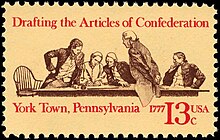Second Continental Congress
During this period, it successfully managed the war effort, drafted the Articles of Confederation and Perpetual Union, adopted the first U.S. constitution, secured diplomatic recognition and support from foreign nations, and resolved state land claims west of the Appalachian Mountains.
[3] The number of participating colonies also grew, as Georgia endorsed the Congress in July 1775 and adopted the continental ban on trade with Britain.
However, by the time British Colonial Secretary Lord Dartmouth received the petition, King George III had already issued a proclamation on August 23, 1775, in response to the Battle of Bunker Hill, declaring elements of Britain's continental American possessions to be in a state of what he called an "open and avowed rebellion".
But with the Revolutionary War escalating, the residents of St. John's Parish in present-day Liberty County sent Lyman Hall to the gathering in Philadelphia on their behalf.
Congress had no authority to levy taxes and was required to request money, supplies, and troops from the states to support the war effort.
Congress was moving towards declaring independence from the British Empire in 1776, but many delegates lacked the authority from their home governments to take such drastic action.
That same day, the Virginia Convention instructed its delegation in Philadelphia to propose a resolution that called for a declaration of independence, the formation of foreign alliances, and a confederation of the states.
He urged Congress to resolve "to take the most effectual measures for forming foreign Alliances" and to prepare a plan of confederation for the newly independent states.
[12] Congress formally adopted the resolution of independence, but only after creating three overlapping committees to draft the Declaration, a Model Treaty, and the Articles of Confederation.
Congress was again forced to flee Philadelphia at the end of September 1777, as British troops seized and occupied the city; they moved to York, Pennsylvania, where they continued their work.
[15] The lone holdout, Maryland, finally ratified the Articles on February 2, 1781, doing so only after Virginia relinquished its claims on land north of the Ohio River to Congress.




